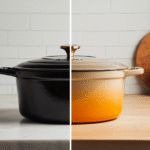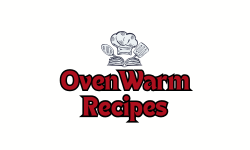Casserole pot for hob and oven was a phrase I never thought much about—until I started using one. I used to juggle pans, skillets, and baking dishes trying to go from stovetop to oven without creating a sink full of dishes. Then I got my first enameled cast iron casserole pot, and everything changed. One casserole pot for hob and oven to brown, simmer, and bake? Yes, please
In this guide, I’ll walk you through why these pots are game-changers for home cooks. Whether you’re whipping up a one-pot stew, baking cheesy casseroles, or just searing meat before a long slow roast, this is the kitchen tool that does it all.
Table of Contents
Why Every Home Cook Needs a Casserole Pot for Hob and Oven
A True One-Pot Wonder: From Stovetop to Oven Seamlessly
If you’ve ever browned ground beef in a skillet and then had to transfer it to a baking dish for the oven—you know the hassle. That’s where the casserole pot for hob and oven shines. It’s designed to handle direct heat from a gas, electric, or induction hob, and then slide right into the oven without skipping a beat.
This versatility doesn’t just save time—it builds flavor. You can sear meat, caramelize onions, and reduce sauces all in one pot before layering ingredients for baking. No flavor lost. No dishes doubled. If you’ve ever made a shaking beef or a rich, layered tater tot casserole, you know how depth of flavor depends on good browning and even cooking. That’s exactly what this pot allows.
Plus, it’s ideal for seasonal dishes like stews in winter or veggie-packed pastas in summer. And because it’s oven-safe, it holds up beautifully whether you’re baking at 350°F or finishing a dish under the broiler.
Cast Iron, Ceramic, or Steel – Which Material Matters Most?
When you’re shopping for a casserole pot for hob and oven, material matters. The three most popular types are:
| Material | Pros | Considerations |
|---|---|---|
| Enameled Cast Iron | Excellent heat retention, non-reactive, great for searing | Heavy, pricier, avoid metal utensils |
| Stainless Steel | Lightweight, durable, quick to heat | Doesn’t retain heat as long |
| Ceramic-Coated | Easy to clean, colorful, oven-safe | May crack with sudden heat changes |
Enameled cast iron is the gold standard—it can go straight from flame to oven and is virtually indestructible if cared for properly. But ceramic and stainless options work beautifully for lighter dishes or quicker cooking.
If you’re cooking protein-forward comfort foods like my marry me chicken pasta or batch-prepping veggie casseroles, choose a pot that can distribute heat evenly and lock in moisture.
Mastering the Casserole Pot for Hob and Oven Cooking
How to Use It Right: From Browning to Baking

Using a casserole pot for hob and oven isn’t complicated—it’s about using one tool to unlock better flavor and fewer dishes. Start by placing your pot directly on the hob (whether it’s gas, electric, or induction). Most cast iron or ceramic-coated models are designed to handle this, but always check the manufacturer’s label just to be sure.
You’ll want to preheat your pot over medium heat, just like you would a skillet. Once it’s hot, sear your meat, sauté veggies, or build your base layer. Then simply add liquids, starches, or toppings—whatever your recipe calls for—and move the entire pot into a preheated oven.
Here’s a great example: for a weeknight version of my tater tot casserole, I brown the ground beef and onions on the hob inside the same pot, stir in the soup and spices, top it with cheese and tots, then bake. The result? Rich, browned flavors with a perfectly crisp top—and no extra pans to wash.
It’s also great for stovetop-to-oven stews, shakshuka, braised meats, or even high-protein flatbreads where you preheat the pot for an ultra-crisp base. If your weeknights revolve around quick meals, having a casserole pot for hob and oven ready to go turns dinner from stressful to seamless.
Cleaning, Storage & Longevity Tips
Maintaining your casserole pot for hob and oven depends on its material. Here’s how to keep it in top shape:

- Enameled cast iron: Let it cool before washing. Use warm water and a soft sponge. Avoid steel wool—it can damage the enamel. Never run it under cold water right off the stove, or it might crack from thermal shock.
- Stainless steel: Soak with warm soapy water for tough bits. Use baking soda paste for stuck-on residue. These pots often go in the dishwasher, but handwashing extends life.
- Ceramic or stoneware: Avoid direct flame if it’s not stovetop-rated. Handwash and avoid high-temperature swings.
Always dry your pot thoroughly to avoid rust or watermarks, especially with cast iron. Store it with the lid off or slightly ajar to avoid trapping moisture. And for extra protection, place a paper towel between the lid and pot to keep air circulating.
If you treat it right, a good casserole pot becomes a lifetime tool. Mine’s been with me through everything from quick late-night dinners to cozy holiday roasts.
FAQs Answered – Getting the Most from Your Casserole Pot for Hob and Oven
Can You Put a Casserole Pot on the Hob?
Absolutely—you can put a casserole pot on the hob if it’s designed for it. Most modern casserole pots made from enameled cast iron, stainless steel, or aluminum core materials are specifically built for stovetop-to-oven use. That’s what makes them so practical. Choosing an induction-compatible casserole pot for hob and oven ensures you’re ready for modern cooking setups without sacrificing durability.
Just be sure to check the bottom for compatibility symbols. A flat base is essential for even heating, especially on induction or glass hobs. Lightweight stoneware or glass casserole dishes should never go on a hob, as they can crack under direct heat.
This versatility is one reason I always use my pot for recipes like shaking beef—where a quick sear transitions into slow braising.
Can You Cook a Casserole on the Hob Instead of the Oven?
Yes, you can cook a casserole entirely on the hob—it just depends on the type of recipe. A stovetop casserole usually simmers rather than bakes, and while you’ll miss that crispy oven top, you’ll still get rich, layered flavors.
If you’re short on time or don’t want to preheat the oven, you can make stovetop versions of dishes like chili, stews, or skillet lasagna. Just keep the heat low and use a tight-fitting lid to trap steam and distribute heat evenly.
For example, you could adapt a baked dish like my marry me chicken pasta by finishing it stovetop in a covered pot with extra broth or cream.
What’s the Difference Between a Cast Iron Casserole Pot and a Dutch Oven?

This one comes up a lot: What’s the difference between a Dutch oven and a cast iron casserole pot? Technically, they’re quite similar—both are heavy, oven-safe, and made from cast iron (usually enameled).
So if you’re baking a stacked veggie casserole or cheesy bake, the casserole pot for hob and oven gives you better surface area. For long-simmering soups or roasts, a Dutch oven wins.
Some brands even use the names interchangeably, but understanding the shape and purpose of each pot is key. For a helpful comparison guide, check out Serious Eats’ roundup of the best Dutch ovens and casserole pots.
Do Casserole Dishes Work on an Induction Hob?
Yes, some casserole pots work on induction hobs—but only if they have a magnetic base. Induction cooking uses electromagnetic energy, which requires cookware made with iron or magnetic steel.
To check yours, just grab a fridge magnet. If it sticks to the bottom, your pot is induction-compatible. Most high-quality enameled cast iron casserole pots are safe for all hob types—including induction.
If you’re planning meals like high-protein flatbread or simple stovetop sauces, an induction-safe casserole pot gives you flexibility, efficiency, and even cooking across all surfaces.
Why Your Kitchen Deserves a Casserole Pot for Hob and Oven
What You Can Make in a Casserole Pot for Hob and Oven – From Comfort Food to Clean Meals
Once you start using a casserole pot for hob and oven, you’ll be amazed at how many dishes suddenly feel easier—and better. This is the tool you’ll reach for on a lazy Sunday when you want dinner to cook itself, or on a busy weeknight when you can’t handle more than one dish to wash.
Here are just a few recipe categories that work beautifully in a hob-to-oven pot:
- Braised meats: Think fall-apart short ribs, coq au vin, or shaking beef-style dishes.
- Creamy bakes: Mac and cheese, tater tot casserole, or lasagna layered right in the pot.
- Soups and stews: Use the hob to sauté aromatics and sear meat, then simmer or finish in the oven.
- Breakfast bakes: Start with a sautéed hash, crack in eggs, and finish under the broiler.
- Plant-based bowls: Steamed lentils, roasted veggies, and spiced chickpea stews (you’ll find variations in our healthy cottage cheese meals).
Looking for lighter fare? It’s also perfect for clean late-night dinners like those in our healthy food roundup—steam, roast, and crisp in one container.
This versatility doesn’t just reduce cooking stress; it inspires more creativity. When you know you only need one pot to create something cozy, flavorful, and healthy, you’re more likely to experiment and actually enjoy the process.

Final Word: Invest Once, Cook Smarter Forever
If you’ve been on the fence about buying a casserole pot for hob and oven, here’s your sign: it’s not just another pot—it’s a long-term kitchen partner. It simplifies your workflow, enhances flavor, and makes cleanup easier. Whether you’re batch-cooking for the week, meal prepping clean proteins, or just trying to get dinner on the table in under 45 minutes, it’s the one piece of cookware that rises to every occasion. Trust me, once you cook with a casserole pot for hob and oven, you’ll wonder how you ever lived without one.
So next time you’re debating between browning in a pan or preheating a baking dish—don’t. Let one pot do it all.
